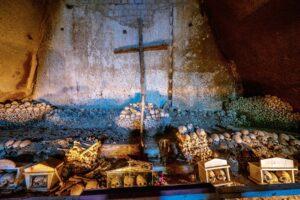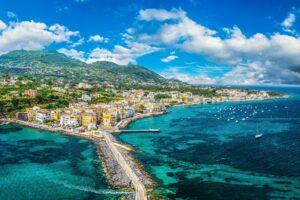Fodor's Expert Review Certosa e Museo di San Martino
Atop a rocky promontory with a fabulous view of the entire city and majestic salons that would please any monarch, the Certosa di San Martino is a monastery that seems more like a palace. The certosa, or charter house, had been started in 1325, but by the 18th century, it had grown so sumptuous that Ferdinand IV was threatening to halt the religious order's government subsidy. Although the Angevin heritage can be seen in the pointed arches and cross-vaulted ceiling of the Certosa Church, over the years dour Gothic was traded in for varicolor Neapolitan Baroque.
The sacristy leads into the Cappella del Tesoro, with Luca Giordano's ceiling fresco of Judith holding aloft Holofernes's head and paintings by Jusepe de Ribera (the Pietà over the altar is one of his masterpieces). The polychrome marble work of the architect and sculptor Cosimo Fanzago (1591–1678) is at its finest here, and he displays a gamut of sculptural skills in the Chiostro Grande (Great Cloister).... READ MORE
Atop a rocky promontory with a fabulous view of the entire city and majestic salons that would please any monarch, the Certosa di San Martino is a monastery that seems more like a palace. The certosa, or charter house, had been started in 1325, but by the 18th century, it had grown so sumptuous that Ferdinand IV was threatening to halt the religious order's government subsidy. Although the Angevin heritage can be seen in the pointed arches and cross-vaulted ceiling of the Certosa Church, over the years dour Gothic was traded in for varicolor Neapolitan Baroque.
The sacristy leads into the Cappella del Tesoro, with Luca Giordano's ceiling fresco of Judith holding aloft Holofernes's head and paintings by Jusepe de Ribera (the Pietà over the altar is one of his masterpieces). The polychrome marble work of the architect and sculptor Cosimo Fanzago (1591–1678) is at its finest here, and he displays a gamut of sculptural skills in the Chiostro Grande (Great Cloister). Fanzago's ceremonial portals at each corner of the cloister are among the most spectacular of all Baroque creations, aswirl with Michelangelo-esque ornament. The nearby Museo dell’Opera, not always open, contains sociology-theme rooms that add up to a chronological tour of the city. One room has 13 gouaches of Vesuvius, and another has paintings depicting the Plague. The Quarto del Priore (Prior's Quarters), the residence of the only monk allowed contact with the outside world, is an extravaganza of salons filled with frescoes, majolica-tile floors, and paintings, plus extensive gardens where scenic pergolati (roofed balconies) overlook the bay.
Entering from the Quarto del Priore side, you come upon two splendid gilded coaches and then the "Vessels of the King" naval museum, with a 20-meter (65-foot) boat occupying a whole room. Beyond this lie two rooms with Early Renaissance masterpieces; subsequent rooms hold works by later artists, including the tireless Luca Giordano. Past the library, with its heavenly majolica-tile floor, comes the Sezione Presepiale, the world’s greatest collection of Christmas cribs. Pride of place goes to the Presepe (Nativity scene) of Michele Cuciniello. Equally amazing in its own way is a crib inside an eggshell.
READ LESS







